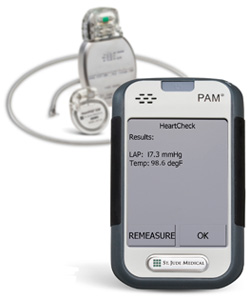
In a similar way that people with diabetes can self-monitor their insulin levels and make adjustments to diet and medication accordingly, heart failure patients can now do the same, thanks to a new implantable device that is the focus of a national clinical trial.
Vanderbilt Heart and Vascular Institute recently enrolled the first patient in Tennessee in the LAPTOP-HF trial, and cardiologists expect this technology could transform the way heart failure is managed.
Christopher Ellis, assistant professor of medicine, implanted a generator the size of a quarter into the chest of the patient, a 49-year-old female. The next day, he used a handheld, wireless device to externally monitor elevated left atrial pressure (LAP) of the heart. The patient was discharged the next day with the knowledge of how to do this on her own.
“By moving this device over the generator in her chest, it tells me her core temperature and LAP instantaneously,” said Ellis.
The LAPTOP-HF trial, an acronym for Left Atrial Pressure Monitoring to Optimize Heart Failure Therapy, is sponsored by medical device company St. Jude Medical. It is a multi-center clinical study to evaluate the safety and effectiveness of the company’s implantable LAP HF management system. Vanderbilt is one of 75 sites in the United States to participate in the trial, which will enroll 700 patients.
The system provides information on the pressure within the heart that allows patients to adjust their medications daily based on a physician-directed prescription plan and their current LAP.
We now have a definitive measurement of heart failure.“The thing that is really unique is that we now have a definitive measurement of heart failure. Measuring left atrial pressure is the most rigorous way we can define it,” said Vanderbilt’s principal investigator for the study, Daniel Lenihan, professor of medicine. “We don’t always know what the pressures are to guide our treatment choices, so we have had to guess. Medications can be effective but they are difficult to regulate. The ability to measure the pressure in the heart is really amazing.”
Changes in LAP precede development of fluid in the lungs and result in worsening heart failure symptoms.

The patient, who received her device on May 10, is one of about 5 million Americans living with heart failure, a chronic condition that, for many, results in worsening symptoms and serial re-hospitalizations.
“Depending on the study results and safety profile, this device could significantly change a patient’s heart failure status,” said Ellis, who expects he will do 20 to 25 of these procedures over the course of the study. “Potentially this could help the right patient, someone who is interested in actively managing their health.”
Physician-directed, patient self-management, which has become standard in diabetes management, is a new approach for heart failure management.
It is intended to provide physicians with the ability to better personalize and optimize its management using daily, objective measures of a patient’s status. By providing patients with daily feedback on their left atrial pressure status and associated prescription instructions, it may also encourage self-management and treatment adherence.
Heart failure occurs when the heart is only able to pump enough blood to meet the body’s demands by elevating pressures within the heart. About 90 percent of patients admitted to a hospital for heart failure have pulmonary congestion related to elevated LAP. The estimated direct and indirect cost of the condition in the United States for 2009 was $37.2 billion.